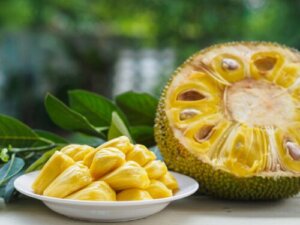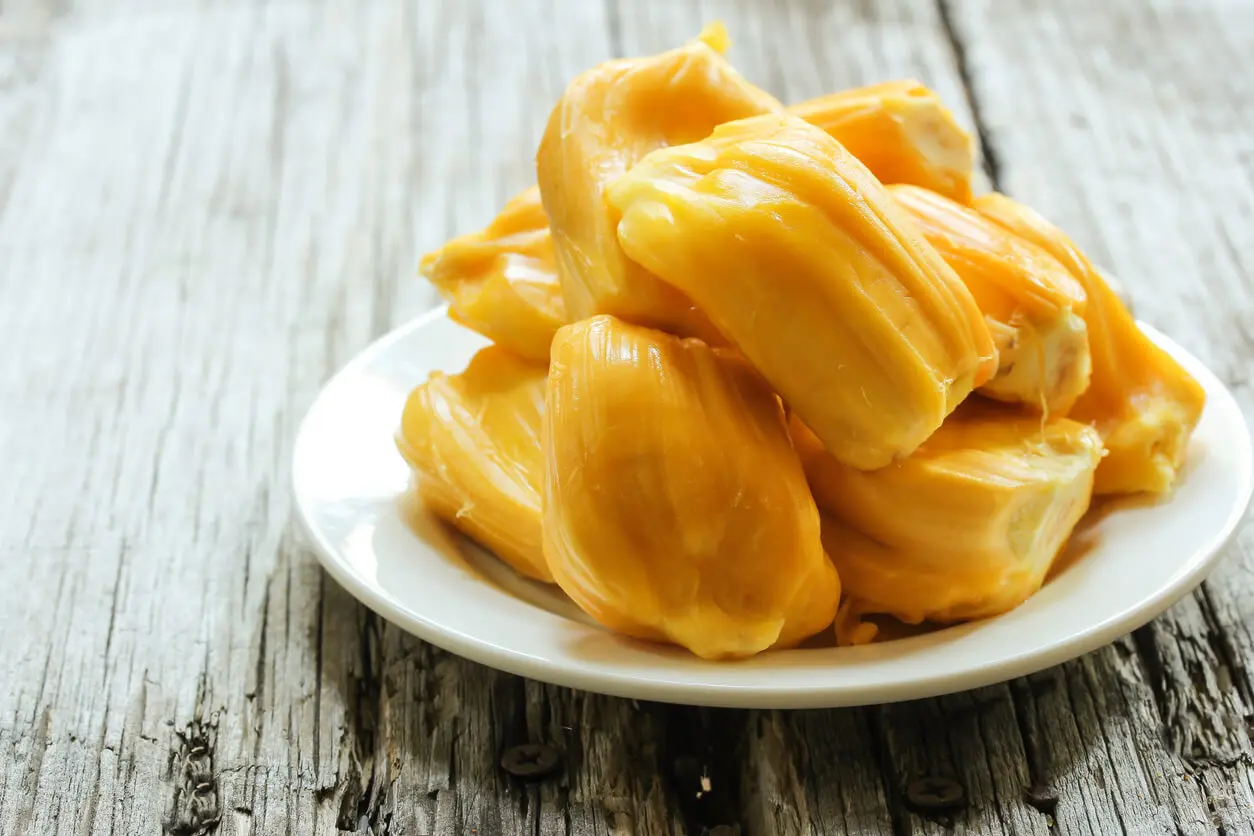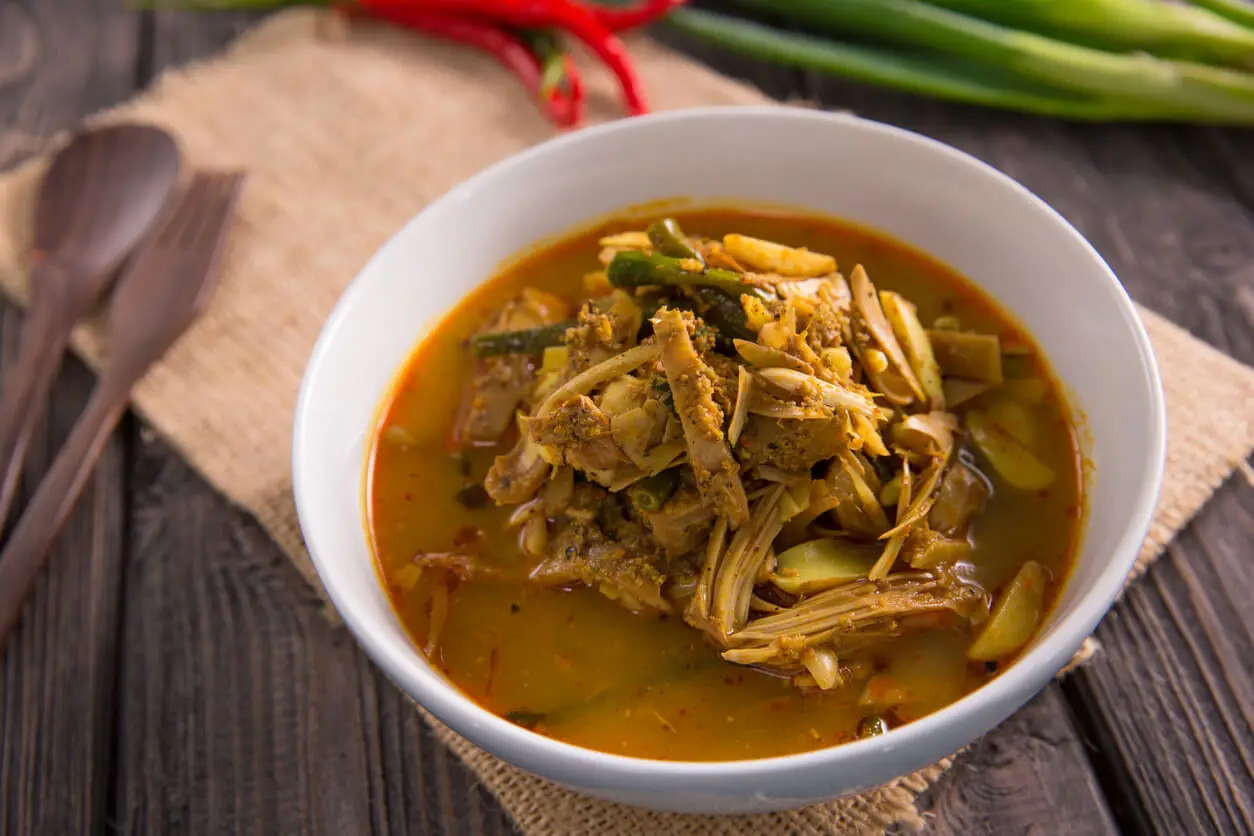Jackfruit: The Fruit that's a Winner Among Vegans


Written and verified by the nutritionist Maria Patricia Pinero Corredor
Jackfruit (Artocarpus heterophyllus Lam.) is a tropical fruit grown in Asia. It’s considered the largest tree fruit in the world, weighing between 25 and 40 kilos (55 to 88 pounds).
Despite having a similar taste to other tropical fruits, for many vegans it’s the ideal substitute for pork. The reason? Sensorially, it has some similar characteristics. However, as far as nutrition is concerned, we need to take a look at some aspects.
For example, just like any other fruit, it provides carbohydrates and almost no protein. Because of this, it isn’t such a good replacement for meat, as we need to ensure optimal nutrient intake. Would you like to find out more about this food?
What kind of fruit is jackfruit?
The tree that produces jackfruit is also simply called jackfruit or jack tree. It belongs to the Moraceae family and is characterized by its huge fruits hanging from its trunks. The botanist José Linares tells us that this fruit contains abundant bioactive compounds and other nutrients that promote well-being.
It’s native to India and the Malaysian peninsula, from where it has spread to the West Indies and the American continent. These days it’s the national fruit of Bangladesh and it’s cultivated in various parts of Asia, Africa and South America.
It’s considered a compound food because it comes from the joining together of many flowers. In the end, the result is a honeycomb-like fruit, where each polygon represents a flower.
It is made up of 3 sections. The center, which isn’t edible, is made up of cells that exude latex of a gummy consistency. The perianth is the edible part along with the outer section, which is the rind of the fruit. It also has a rough skin with sharp points, which is green and brown when ripe.

Nutritional and bioactive components
According to the United States Department of Agriculture (USDA), one 165-gram (6.5 oz) cup of raw, ripe, sliced jackfruit contains the following range of nutrients:
- Carbohydrates: 38.3 grams (1.5 oz)
- Sugars: 31.5 grams (1.2 oz)
- Starch: 2.42 grams
- Glucose: 15.6 grams (0.6 oz)
- Fructose: 15.2 grams. (0.6 oz)
- Fiber: 2.48 grams
- Protein: 2.84 grams
- Fat: 1.06 grams
- Calories: 157 calories
- Water: 121 grams (6 oz)
- Potassium: 739 milligrams
- Magnesium: 47.8 milligrams
- Vitamin C: 22.6 milligrams
- Lutein and zeaxanthin: 259 micrograms
Its main nutrient is carbohydrates. When ripe, glucose and fructose sugars predominate in equal parts. Starch is found in smaller proportions. However, when it’s green, sugars predominate.
The presence of sugars makes it easier for the calories contained in a cup of jackfruit to be burnt up quickly, since they’re absorbed directly into the intestinal lumen.
On the other hand, the nutritional information shows that, like other fruits, it has few proteins and fats. In meats, the opposite occurs, proteins and fats are high, especially in pork.
The water and potassium content is very high, which maintains a good hydroelectric balance. Vitamin C covers 25% of the requirement for an adult. The fruit should be eaten fresh and raw, as processing, heat, and light destroy vitamin C.
It’s also important for its lutein and zeaxanthin content. These two carotenoids have no vitamin A effect, but are potent antioxidants involved in eye health. Beta-carotenes are found in about 245 international units per 100 grams (4 oz) of fresh fruit.
Find out more here: Delicious Vegan Soy Burger Recipe
Bioactive components of jackfruit
A recent report published the antioxidant properties of jackfruit. The content of total phenols as the main antioxidants is 58.44 milligrams per 100 grams (4 oz) of fruit. This value is slightly lower than that of other fruits such as strawberries and raspberries.
The remaining antioxidants in the fruit are beta-carotene and vitamin C. Several studies support the therapeutic health effects of flavonoids.
In addition, any of these compounds counteract the effects of free radicals, which are responsible for causing oxidation of cell membranes and DNA damage. In turn, this is associated with the prevention of cardiovascular diseases, aging and cancer.
Why does it succeed as a meat substitute?
The reason that vegans could consider it a meat substitute is sensorial. Its appearance resembles the muscle fibers of meat and, when cooked, it develops a pork flavor. In addition, it works well with any ingredient when prepared.
When green, it has a pale, starchy flesh and a texture that can fray. This has made it prominent in vegan cooking, especially in savory dishes. It’s also ideal as a filling for sandwiches or to accompany rice.
On the other hand, the ripening process helps to nuance different preparations. When they’re green they can substitute meats, but when they ripen they become the ideal fruit for pastries.
The usage and benefits of jackfruit in vegan cooking are clear. It has a low caloric intake, a good appearance and adapts to dishes. However, it doesn’t provide the same protein, fat, vitamin and mineral content as meats.
Culinary use of jackfruit
The fruit can be consumed in the following ways:
- Marinated with spices and aromatic herbs for stews or stir-fries (green).
- Vegetable meat (green).
- Pureed or in soups (green).
- In desserts, jams, jellies, popsicles and ice creams (ripe).
For their part, the seeds are consumed cooked or roasted like chestnuts. In dry form, they are used to make flour and sweets, or simply boiled as snacks.
To prepare it as a preserve, you must drain it well and wash it with enough water, keeping it submerged for 30 minutes. Then, you have to change the water and submerge it again. This will eliminate the final acid taste of the pulp.
Another way is to boil the pulp for 10 to 15 minutes. Then drain it and add enough cold water to drain again. If you find that the acidity persists, then add a little sugar, until you find the perfect balance.

More information for you here: Vegan Meat Substitutes: What Are the Best Options?
Is jackfruit suitable as a meat substitute?
Vegan eating has many advantages and is related to healthy living. When using jackfruit as a meat substitute, you should be careful. It must be remembered that it’s a fruit, with sugars, very little protein, and almost no fat.
Therefore, although in appearance it could simulate a pork chop, at a nutritional level they don’t compare. Because of this, you’ll need to supplement your protein intake.
However, by following the recommendations, vegans who incorporate jackfruit will receive enough antioxidant vitamins, phenols, minerals, and a low calorie content that will help promote their health.
All cited sources were thoroughly reviewed by our team to ensure their quality, reliability, currency, and validity. The bibliography of this article was considered reliable and of academic or scientific accuracy.
- Luna-Esquivel G ; Alejo-Santiago G .; Ramírez-Guerrero L. G.; Arévalo-Galarza Ma. de Lourdes C. La Yaca. Un fruto de Exportación. Disponible en: http://dspace.uan.mx:8080/jspui/bitstream/123456789/784/1/La%20Yaca%20%28Artocarpus%20heterophyllus%20Lam.%29.%20Un%20fruto%20de%20exportaci%C3%B3n.pdf
- Linares J. L. 2003 [2005]. Listado comentado de los árboles nativos y cultivados en la república de El Salvador. Ceiba 44(2): 105–268. Disponible en: https://pdfcoffee.com/arboles-de-el-salvador-linares-ceiba-2-pdf-free.html
- National Institute of Health. Vitamina C. Disponible en: https://ods.od.nih.gov/factsheets/VitaminC-DatosEnEspanol/
- Fundación Española de Nutrición. Fedecarne. Guía Nutricional de la Carne. Disponible en: https://www.fen.org.es/aplicaciones/fedecarne-fen/pdf/guiaNutricion.pdf
- North Carolina Department of Agriculture and Consumer Services. Luteína y Zeaxantina: ¿en qué alimentos conseguirlos? Disponible en: http://www.ncagr.gov/fooddrug/espanol/documents/luteinayzeaxanthina.pdf
- Cantillo-Zacarías, J. C., García-Mateos, R., Esparza-Torres, F., Martínez-Damián, T., & Hernández-Ramos, L. (2021). Calidad nutricional y antioxidante del fruto de Jaca (Artocarpus heterophyllus). Current Topics in Agronomic Science, 1(1), 1-9. http://dx.doi.org/10.5154/r.ctas.2021.06.17a
- Soto-Hernández, M., Palma-Tenango, M., & Garcia-Mateos, M. del R. (Eds.). (2017). Phenolic Compounds – Biological Activity. InTech. https://doi.org/10.5772/63693
- Luna-Esquivel, G. (2018). La Yaca (Artocarpus Heterophyllus Lam.) un fruto de exportación. Agro Productividad, 6(5). Recuperado a partir de https://revista-agroproductividad.org/index.php/agroproductividad/article/view/486
This text is provided for informational purposes only and does not replace consultation with a professional. If in doubt, consult your specialist.








